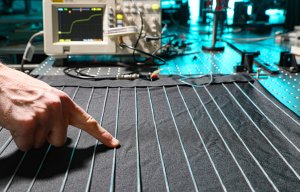
From step counting to the clinic on the wrist
These new buckypaper sensors represent a marked improvement on current industry standards, according to researchers.

24th November 2017
Innovation in Textiles
|
Tallahassee, FL
Researchers from the FAMU-FSU College of Engineering have developed a class of motion sensors that they say could herald a near future of ubiquitous, fully integrated and affordable wearable technology.
In a paper published in the journal Materials and Design, engineers from FSU’s High-Performance Materials Institute, in collaboration with scientists from Institut National des Sciences Appliquées in Lyon, France, detail the properties and cost-effective manufacturing process of an advanced series of motion sensors made using buckypaper — razor thin, flexible sheets of pure, durable carbon nanotubes.
These new buckypaper sensors represent a marked improvement on current industry standards, with most sensors being either too crude or too inflexible to reliably monitor complex structures like the human body, according to researchers.
“Current technology is not designed for that,” said Richard Liang, director of the High-Performance Materials Institute and professor at the FAMU-FSU College of Engineering. “For sensor technology, you need it to be flexible, you need it to be affordable and you need it to be scalable. This new technology is versatile, and the sensors are affordable to print. It’s a big innovation that presents many possibilities down the road.”
At this stage, potential applications for the printable buckypaper sensors are numerous, according to the team of researchers. The low-profile design could be integrated into bedsheets to monitor quality of sleep, shoes to track step count and posture or workout clothes to measure intensity of exercise.
Researchers also foresee potential applications beyond the realm of wearable technology. In the field of soft robotics, the material could facilitate advances in the production of responsive, self-correcting artificial muscles.
Moreover, the scalable sensors represent another step toward the long-predicted future of an “internet of things,” where virtually all of an individual’s computers, devices, garments, furniture and appliances are digitally connected to freely exchange information in the cloud.
“Most projects don’t have this many possible applications,” said doctoral candidate Joshua DeGraff, the lead author of the study. “This material could be used in structural health monitoring, wearable technology and everything in between. I’m excited because this is something that can affect a lot of people in their everyday lives.”
The novel sensor structure combines a strip of seven micron-thin buckypaper with silver ink electrodes printed from a common, commercially available ink-jet printer. The result is a kind of perfect Goldilocks sensor: not as insensitive as common, flexible metallic sensors, but not as rigid or cumbersome as popular, more sensitive semi-conductor sensors. The wearable buckypaper sensors are flexible, seamless and sensitive to subtle movements and strains.
“We measure sensors by gauge factor, which indicates how much resistance value changes as a material is strained or bent,” said Mr DeGraff. “Our gauge factor has been up to eight times higher than commercial sensors and 75% higher than many other carbon nanotube sensors.”
As development of the printable sensor technology continues, researchers hope to improve upon the already remarkable thinness of the material so that it can be integrated into comfortable and non-restrictive clothing. Additional testing on complex model structures is required to ensure the material’s ability to conform to the variable curves and crevices of the human body.

Business intelligence for the fibre, textiles and apparel industries: technologies, innovations, markets, investments, trade policy, sourcing, strategy...
Find out more